Make the perfect pavlova every time with this easy pavlova recipe with step-by-step photos. Tips on how to make a pavlova with a crisp meringue shell and soft and chewy marshmallow centre.
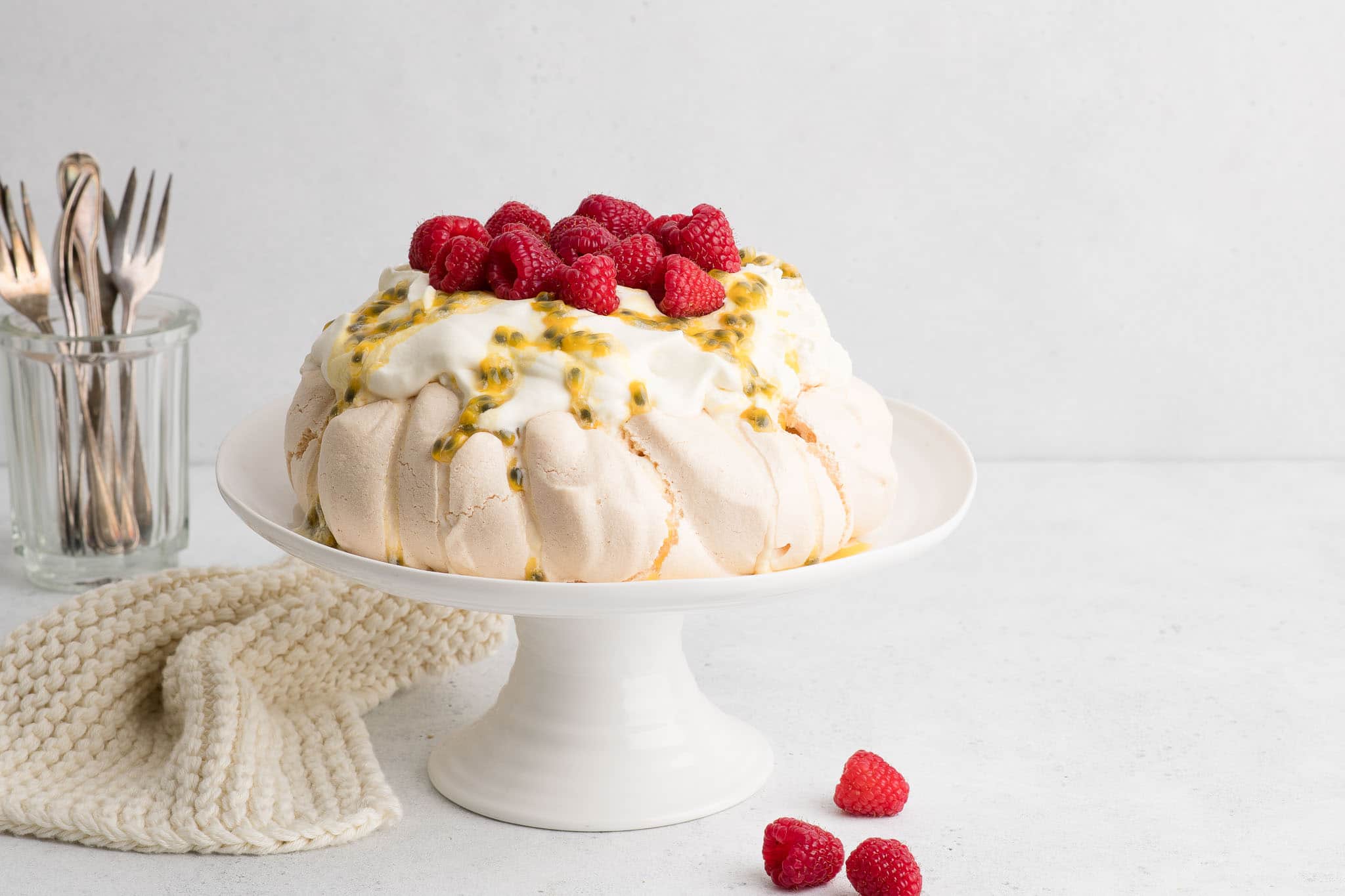
Australian Pavlova
There is nothing which reminds me more of Australia than a classic pavlova. This was something I grew up eating at parties and celebrations, and a backyard BBQ was never complete without a pavlova dessert standing proud and tall on the kitchen table.
What is a Pavlova?
A pavlova is essentially one large meringue, topped with lashings of whipped cream and decorated with fruit.
For me, it is also really important that the pavlova is tall and high – a sign of a successful pavlova.
Why This Pavlova Recipe Works
My recipe below gives you comprehensive tips on how to make a beautifully tall pavlova with the perfect crust and soft, chewy centre.

Easy Pavlova
A pavlova, if you get it right, can be a very easy dessert to make.
If we are having friends over for dinner, I simply make the pavlova first thing in the morning and then leave it unattended for the rest of the day, until just before serving when I will disappear into the kitchen to whip the cream and prepare the fruit topping.
And considering that I always have a stash of egg whites in the freezer, a pavlova can be a fairly economical dessert.
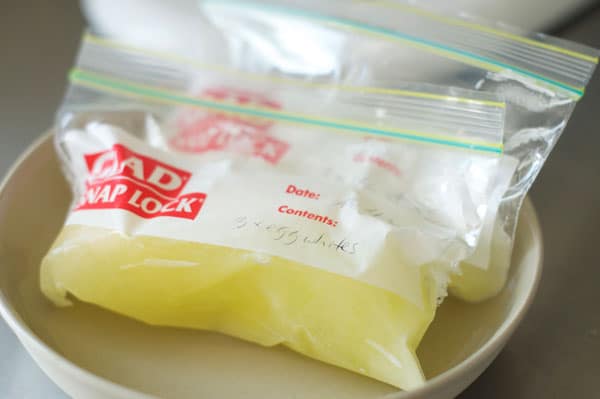
Pavlova Recipe
My pavlova recipe is adapted from Nigella Lawson, who adapted her recipe from the revered Australian cook, Stephanie Alexander.
It is a recipe which I turn to every time I want to make a pavlova, and which happens to be often because I consider pavlova to be an “easy” dessert which I can make with very few ingredients.
Plus, pavlova happens to be gluten-free, so this dessert appears every time I need to accommodate gluten-intolerance.
You could even make the complete dessert dairy-free by using coconut yoghurt in place of the whipped cream.
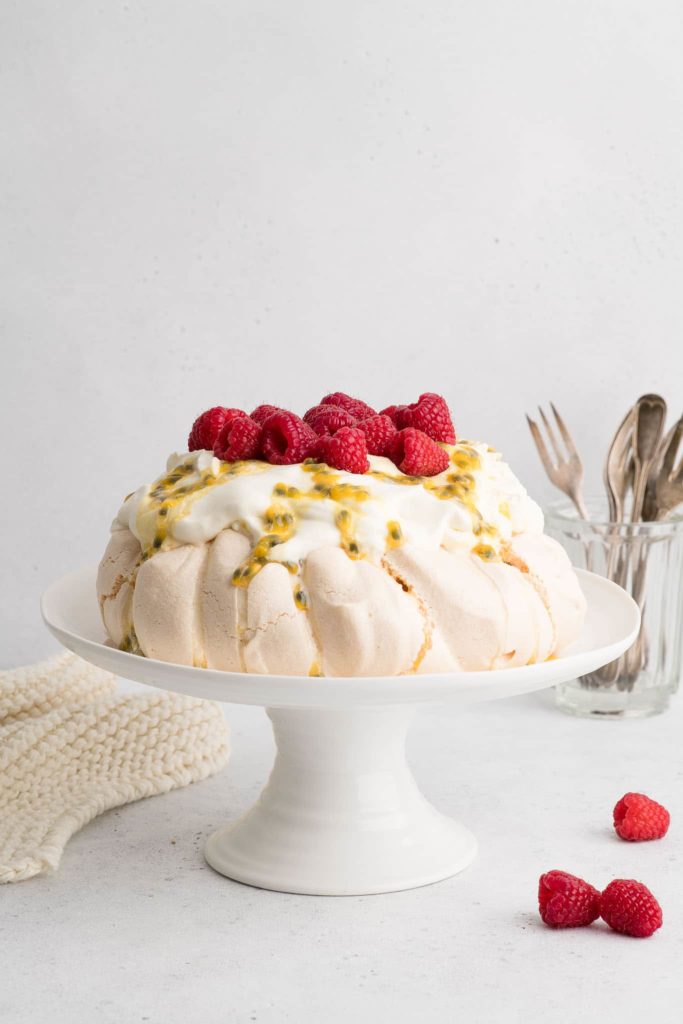
How to Make Pavlova
Step 1
Unless you really want to have a heavy duty upper arm workout, an electric stand mixer or an electric hand-held beater is an essential equipment when making a pavlova.
Place the egg whites into a large, clean bowl that is free from any grease.
To ensure that the egg whites whip up nicely, make sure that they are at room temperature.
Step 2
Whisk the egg whites until they have tripled in volume and form soft peaks when you lift the beaters.
Soft peaks mean that, when you lift the beaters, the mixture forms a peak which falls over or which does not stand.
At this stage, the beaten egg whites should look very soft and foamy.
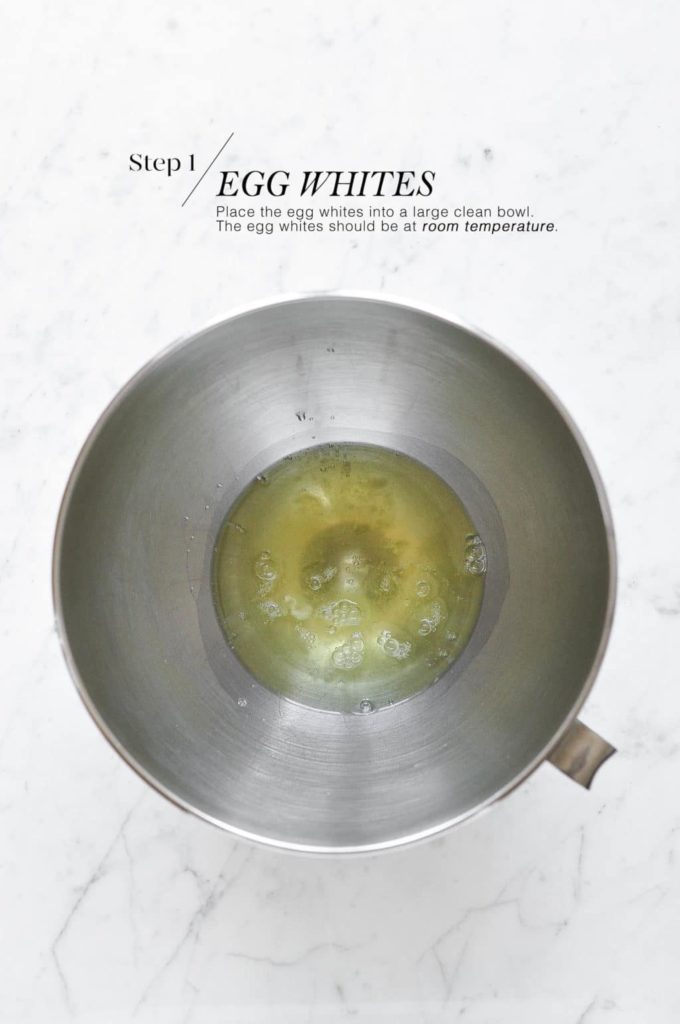
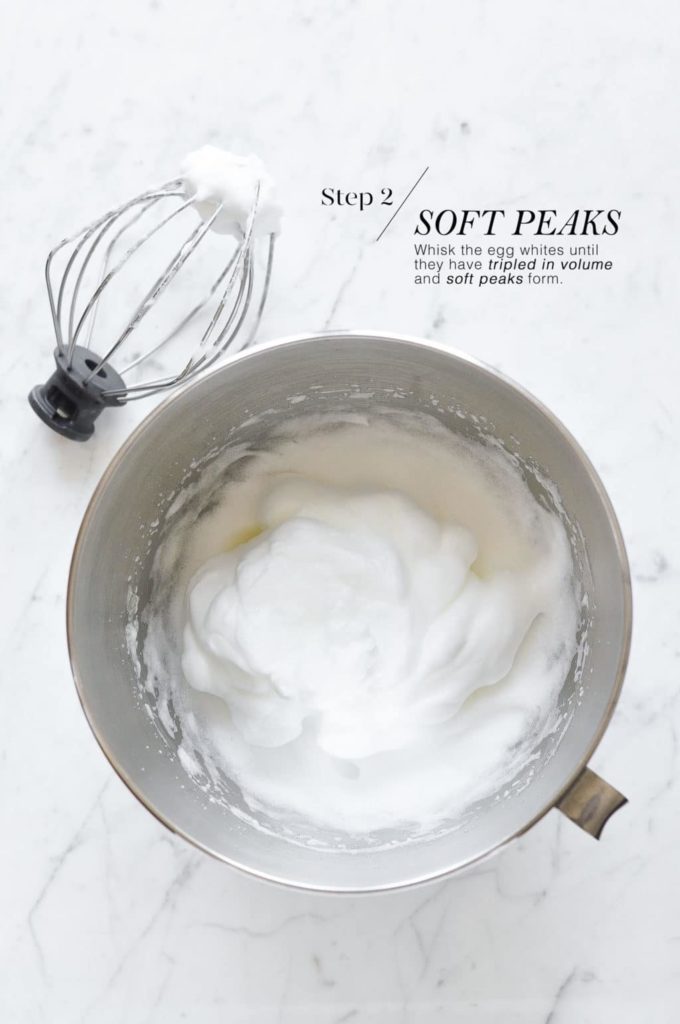
Step 3
Next, add the sugar, one spoon at a time, until the egg whites transform into a thick and glossy mixture, and stiff peaks form when you lift the beaters.
Stiff peaks mean that, when you lift the beaters, the mixture forms a peak which holds its shape.
It is important to make sure that the sugar has been completely dissolved in the egg white mixture, but it is also important to not over-beat the mixture once you start adding the sugar.
To test that the sugar has been completely dissolved, simply rub a bit of mixture in between your finger tips.
Step 4
Add the cornflour, vinegar and vanilla. A few rotations of the stand mixer should be enough to mix in these ingredients.
The resulting pavlova mixture should be thick and firm, and it should hold its shape when you start piling it on the baking tray.
If the pavlova mixture is soft and runny, and you are unable to shape it into a high pavlova because the mixture keeps sliding, it means that you may have overbeaten the eggwhites or that you added the sugar too soon. Please see the FAQs below.
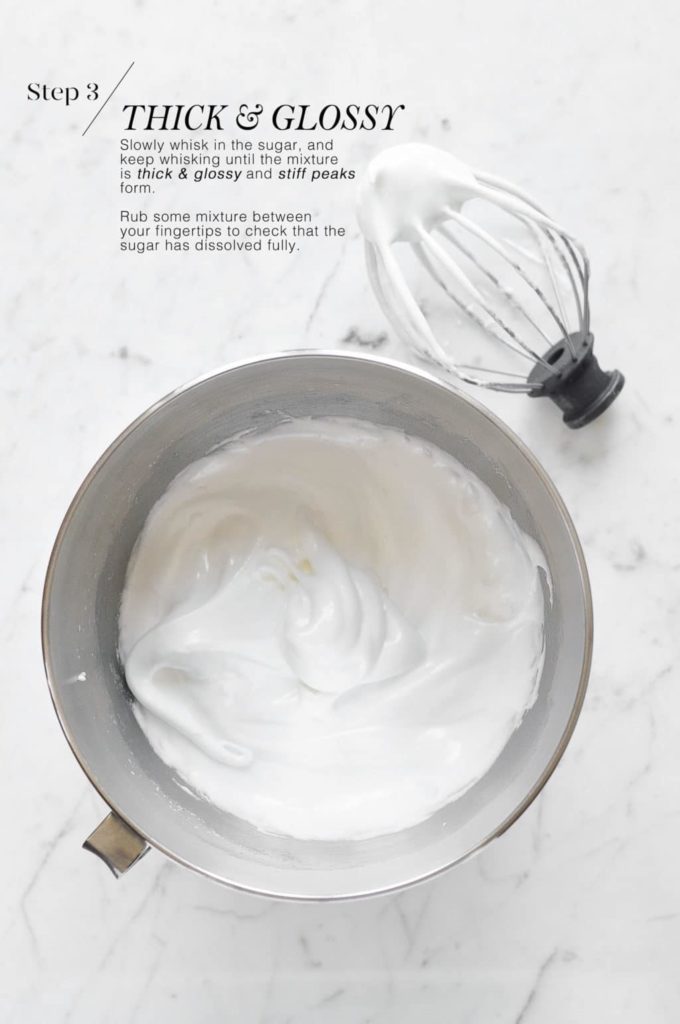
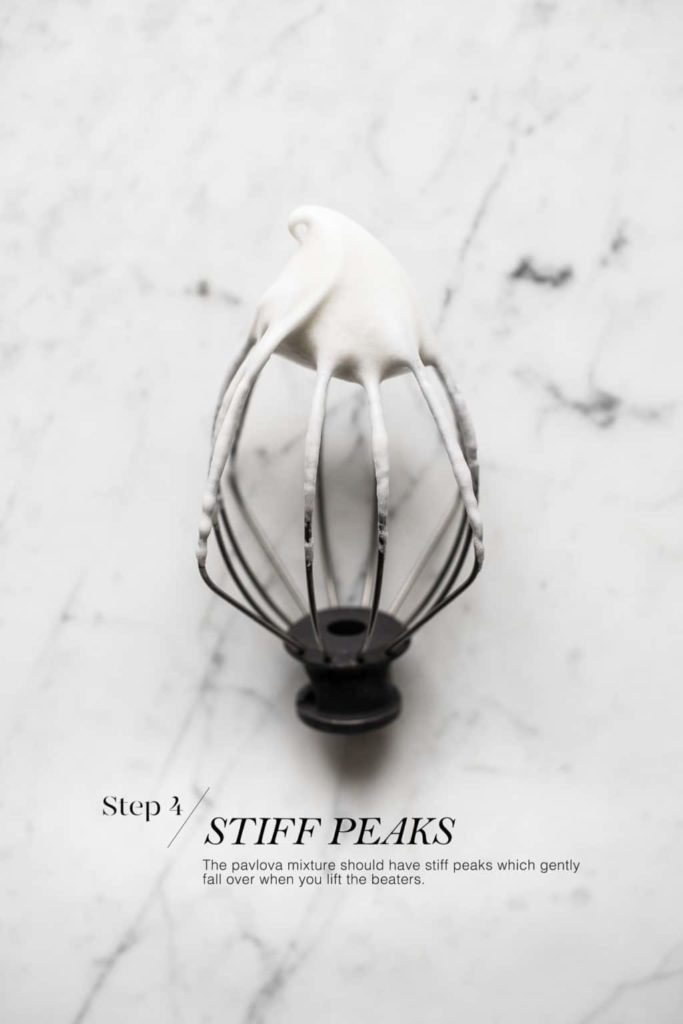
Step 5
Shape the pavlova on a baking tray lined with baking paper.
I recommend that you smooth the top of the pavlova so that it is relatively flat. This is so the whipping cream and any toppings which you add later can sit nicely on the pavlova.
If your pavlova is domed in shape, any cream and toppings which you add later will quickly slide off.
Step 6
Place the pavlova into the oven at 180°C/350°F.
Immediately turn down the temperature to 150°C/300°F.
Let the pavlova bake for 1 hour and 15 minutes, and do not open the oven door during this time.
After the baking time, turn off the oven, and leave the pavlova to cool inside the closed oven for at least 2-3 hours, or preferably overnight.
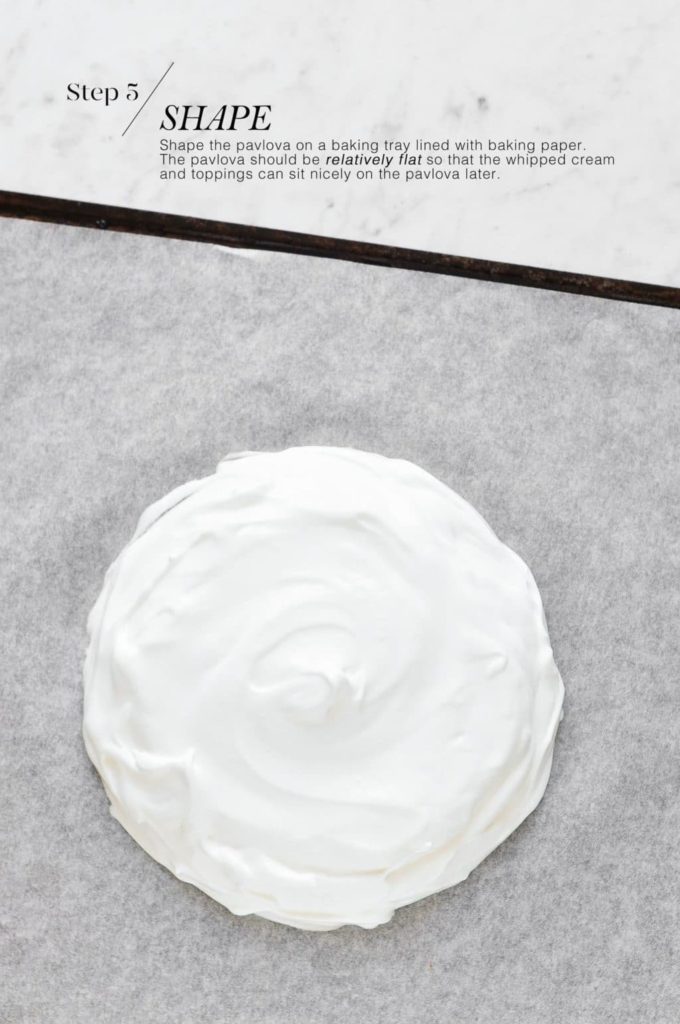
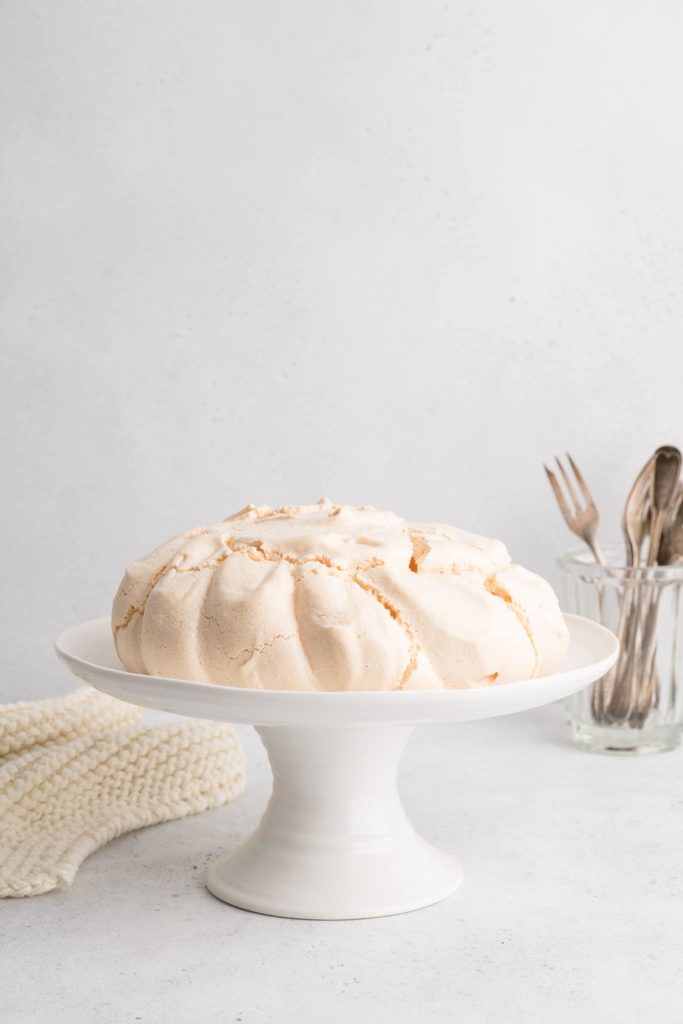
Tips for Making the Perfect Pavlova
Perhaps what some people find intimidating about making a pavlova is that it can be prone to failure. The secret lies in understanding the food science behind making a meringue.
The following are my tips on how to make pavlova perfectly every time.
- Make it in advance: I recommend making the pavlova the night before serving, or in the morning if you plan on serving it later in the evening. This will give the pavlova plenty of time to cool and dry in the oven for the perfect crisp meringue shell and slightly chewy centre.
- Use old eggs: When making a meringue or pavlova, using the egg whites of old eggs is preferable to those of really fresh eggs. What works really well are frozen egg whites. Simply freeze 2 or 3 egg whites per freezer bag for quick defrosting and let them come to room temperature before using.
- Adjust the baking and cooling time: Some people like their pavlova to be crisp on the outside with a slightly chewy centre. Others like their pavlova to be only slightly crisp on the outside, but soft and marshmallowy on the inside. I belong to the first group. If you fall into the latter group, bake your pavlova for only about 45 minutes to 1 hour, and leave it to cool in the oven for only a few hours.
- Flatten the top of the pavlova: Although a nicely domed pavlova looks lovely when naked and unadorned, it’s not very practical if you plan to cover it with whipped cream as it will simply run down the sides. So make sure the top of the pavlova is somewhat flattened before you put it in the oven.
- Stick down the baking paper: If your oven has a strong fan, “glue” the baking paper to the baking tray with some pavlova mixture on each corner. Otherwise, during baking, the baking paper may fly up and stick to the pavlova.
- Don’t worry about cracks: It’s normal if the top of your pavlova cracks as it cools. And don’t worry because you will be covering it with whipped cream anyway.
- Decorate just before serving: Although I recommend baking the pavlova in advance, you should only decorate the pavlova at the last minute. Once the cream is placed on the pavlova, it will start to soften the pavlova and add weight, and your pavlova might collapse soon after.
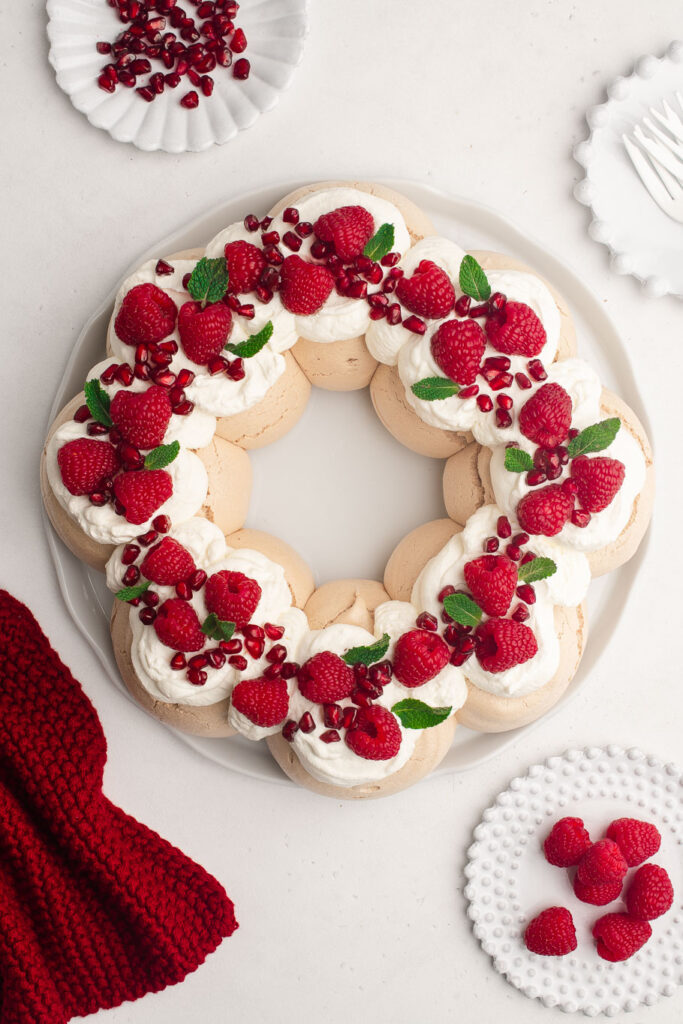
Toppings for Pavlova
In Australia, the following are popular toppings for pavlova:
- passionfruit
- passionfruit and raspberries
- kiwi fruit and banana
- raspberries and strawberries
As the meringue base is quite sweet, sour fruits tend to work best to off-set the sweetness, together with the whipped cream (which should be unsweetened) to soften the crunchy exterior.
Print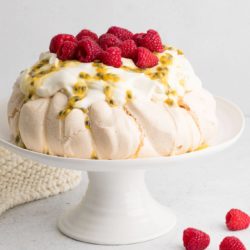
Classic Pavlova
- Resting Time: 3 hours
- Prep Time: 20 mins
- Cook Time: 75 mins
- Total Time: 1 hour 35 minutes
- Yield: Serves 3-4
- Category: Desserts
- Method: Oven
- Cuisine: Australian
Make the perfect pavlova every time with this easy pavlova recipe with step-by-step photos. Tips on how to make a pavlova with a crisp meringue shell and soft and chewy marshmallow centre.
Ingredients
For the pavlova
- 3 egg whites
- 180 g (½ cup plus ⅓ cup) caster sugar (superfine sugar)
- 1½ teaspoons cornflour (US: cornstarch)
- 1 teaspoon white wine vinegar
- 1 teaspoon vanilla extract or vanilla bean paste
For the topping
- 250 ml (1 cup) double cream (heavy whipping cream)
- 3–4 passionfruits
- raspberries
Instructions
To make the pavlova
- Preheat the oven to 180°C/350°F (without fan).
- Using a standmixer or electric beaters, whisk the egg whites in a large, clean bowl until they have tripled in volume and soft peaks form.
- Turn the speed down to low and slowly add the caster sugar, one spoon at a time until the sugar is well incorporated. As you add the sugar, the mixture will start to become thick and glossy, and stiff peaks will form when you lift the beaters.
- Remember to scrape down the sides of the bowl.
- Rub a bit of the mixture between your fingertips to test if the sugar has been fully dissolved; if you don’t feel any grains of sugar, move onto the next step.
- Add the cornflour, white wine vinegar, and vanilla extract. I do this on low speed with the stand mixer for only 2 to 3 rotations (about 1 second).
To shape the pavlova
- Line a baking tray with baking paper and spoon the pavlova mixture onto the tray into a round shape. I like to dollop the mixture on top of each other into a high pile, and to then shape the pavlova from there – using this method ensures that your pavlova will have some height.
- Use a palette knife to shape the sides of the pavlova and to slightly flatten the top. The pavlova will expand and rise once cooked, so shape it to be on the slightly smaller side.
To bake the pavlova
- Place the pavlova in the oven and immediately turn the temperature down to 150°C/300°F (without fan).
- Bake for 1 hour and 15 minutes. Do not open the oven door during this time.
- After 1 hour and 15 minutes, turn off the oven and leave the oven door closed so the pavlova can cool down completely. You should leave the pavlova in the oven for at least 2-3 hours, but overnight (12-18 hours) is best.
To decorate the pavlova
- The pavlova should be decorated only just before serving.
- Whip the double cream until it is thick and soft.
- Spread the cream over the top of the pavlova.
- Drizzle over the passionfruit pulp, and top with raspberries.
- For a quick assembly, you can whip the cream and prepare the passionfruit pulp ahead of time and leave them in fridge until needed.
Kitchen Notes
![]() PAVLOVA FOR 4 TO 6 PEOPLE
PAVLOVA FOR 4 TO 6 PEOPLE
To make a slightly larger pavlova, I recommend the following recipe:
4 egg whites
240 g (1 cup plus 1 tablespoon) caster sugar (superfine sugar)
2 teaspoons cornflour (cornstarch)
1 1/4 teaspoon white wine vinegar
1 1/4 teaspoon vanilla extract
 CHRISTMAS PAVLOVA WREATH
CHRISTMAS PAVLOVA WREATH
Use the recipe above for 4 to 6 people. Draw a 25 cm/10 inch circle on a sheet of baking paper and turn it over (so that the ink is not touching the pavlova). Use a large piping bag to pipe 8 large rounds within the circle. Alternatively, use a large spoon to dollop the mixture into a wreath shape. Bake for 1 hour. See full recipe for a Christmas Pavlova Wreath.
 MAKE IT IN ADVANCE
MAKE IT IN ADVANCE
I recommend making the pavlova the night before serving, or in the morning if you plan on serving it later in the evening. This will give the pavlova plenty of time to cool and dry in the oven for the perfect crisp meringue shell and slightly chewy centre. You could even make the pavlova 1-2 days in advance and keep it in an air-tight container.
 CRISP & CHEWY VS SOFT & MARSHMALLOWY
CRISP & CHEWY VS SOFT & MARSHMALLOWY
Some people like their pavlova to be crisp on the outside with a slightly chewy centre. Others like their pavlova to be only slightly crisp on the outside, but soft and marshmallowy on the inside. I belong to the first group. If you fall into the latter group, bake your pavlova for only about 45 minutes to 1 hour, and leave it to cool in the oven for only a few hours. Shaping a tall pavlova will also help to create a softer interior.
 MAKE A WHITE PAVLOVA
MAKE A WHITE PAVLOVA
The above recipe will produce a lightly-coloured pavlova. To make a white pavlova, and which will have a thin, crispy shell and a marshmallow centre:
* Omit the vanilla;
* Pre-heat the oven to 150°C (300°F);
* Bake the pavlova at 110°C.
 MAKE ETON MESS
MAKE ETON MESS
If something goes wrong and your pavlova collapses into a flat pancake once cooled, don’t despair – your pavlova will still taste great. Simply crumble the pavlova into a large serving bowl, stir through the whipped cream and passionfruit and you will have something similar to an Eton Mess (which is traditionally made with whipped cream and strawberries).
 OVEN TEMPERATURES All recipes on this website state temperatures for a regular oven (i.e. a conventional oven without fan). If you have a convection oven with a fan, please consult the manufacturer’s handbook on how to adjust the temperature and baking time accordingly.
OVEN TEMPERATURES All recipes on this website state temperatures for a regular oven (i.e. a conventional oven without fan). If you have a convection oven with a fan, please consult the manufacturer’s handbook on how to adjust the temperature and baking time accordingly.
 CONVERSIONS To convert from cups to grams, and vice-versa, please see this handy Conversion Chart for Basic Ingredients.
CONVERSIONS To convert from cups to grams, and vice-versa, please see this handy Conversion Chart for Basic Ingredients.
Nutrition
- Serving Size: 4
- Calories: 441 per serve
- Sugar: 55.3g
- Sodium: 66.1mg
- Fat: 21.7g
- Carbohydrates: 59.5g
- Fiber: 3.1g
- Protein: 5g
- Cholesterol: 67.2mg
#eatlittlebird
FAQs
Why is my pavlova mixture soft and runny? If you start adding the sugar before the egg whites have reached the soft peak stage, or if you beat the egg whites for too long and are too far beyond the stiff peak stage, your meringue mixture will be soft and runny and won’t hold its shape once on the baking tray.
Why did my pavlova not rise? If you don’t properly incorporate the sugar until it dissolves completely, your pavlova may weep and fail to rise magnificently; it may even collapse.
Why did my pavlova collapse? If you open the oven door too soon, the sudden change in temperature may also cause your pavlova to fall and crumble. Even making a pavlova in humid temperatures can be problematic.
How can I rescue my flat pavlova? If something goes wrong and your pavlova collapses into a flat pancake once cooled, don’t despair – your pavlova will still taste great. Simply crumble the pavlova into a large serving bowl, stir through the whipped cream and passionfruit and you will have something similar to an Eton Mess which is traditionally made with strawberries.
How far in advance can I make a pavlova? I recommend baking the pavlova the night before you plan to serve it, or at least 5 to 6 hours before serving to give the pavlova time to cool and dry properly.
How long should the pavlova cool? I recommend at least 5 to 6 hours for the pavlova to cool and dry in the oven.
How far in advance can I decorate the pavlova? You should decorate the pavlova at the last minute, just before serving. Once you add whipped cream to the pavlova, the pavlova shell will start to soften and it may even collapse shortly after.
What causes a pavlova to be chewy? A pavlova is similar to a meringue, except that it also contains cornflour (cornstarch) and vinegar to produce a chewy centre. Allowing the pavlova to cool and dry in the oven for as long as possible also helps to make the pavlova extra crispy on the outside and chewy in the middle.
What makes a pavlova soft in the centre? If you don’t want a chewy pavlova and prefer instead a soft centre with more of a marshmallow texture, I suggest shaping a tall pavlova and to bake the pavlova for slightly less time (about 1 hour if using the recipe above).
Why is my pavlova brown? A pavlova will be “brown” or lightly-coloured if you use vanilla extract or vanilla bean paste, and if you bake it at a high temperature. This recipe starts by preheating the oven at a high temperature of 180°C (250°F) which helps to crisp up the shell. To make a white pavlova, you will need to omit the vanilla and bake at a lower temperature. See the recipe above for further instructions in the Kitchen Notes. However, please note that, by baking the pavlova at a lower temperature, the resulting pavlova will have a thinner shell and softer interior.
All of the aforementioned has happened to me in my quest to master this dessert. But practice makes perfect, and once you get an idea of what the beaten egg whites should look and feel like before you add the sugar and the rest of the ingredients, making pavlova will become second nature to you.
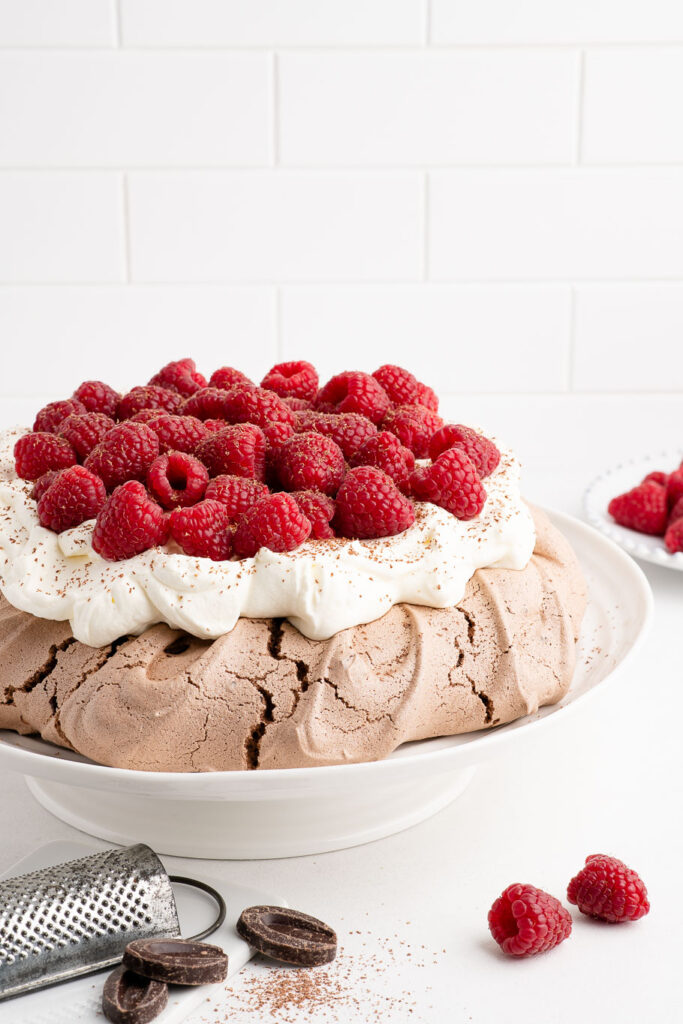
Update
This recipe was first published on 23 April 2014. It has been updated with new photos and more comprehensive recipe notes.
 Print
Print Pin Recipe
Pin Recipe Rate
Rate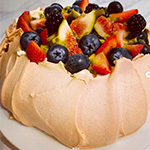
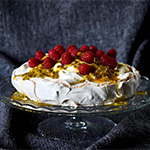

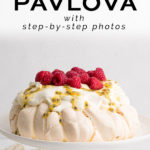
Passionfruit to date, is the best fruit to top a pavlova with. Raspberries a close second. And this comes from someone who isn’t an overly huge pavlova fan, but has a husband who is. It’s often the most requested dessert folk as me to bring or make for dinner. And it always looks incredibly impressive, no? I feel for you; that guest’s reaction wasn’t quite polite, especially if his face betrayed his horror. It’s not happened yet but when it does (happens to everyone at some point) I know I’ll wanna Indian head slap him/her!
Ah ha! It was the first time I had ever had a guest decline dessert in my home, but I’ve always felt it was his loss 😉 But I’ve also seen others look weary about the amount of cream but still go on to enjoy dessert. Or perhaps they were being polite! Maybe you sort of need to grow up with pavlova in your childhood to really appreciate it. And yes, I love that a pavlova always look so ceremonious on a cake stand when you’ve actually done so little to it. You must make a great pav if it’s one of your most popular desserts!
While I’d LOVE to take on your compliment, I can’t! I used to make an ace one in Aberdeen but it’s harder here. I blame the humidity. My meringues end up collapsing, though I am quite careful about the sugar dissolving into the meringue. I think the heat of my cavernous oven might be the culprit as it doesn’t come down in temperature fast enough (not temp sensitive at all), thus causing the meringue to rise quickly but destabilise in the end 🙁 I chuckled at your rescue recipe cos I’ve done that before too! I made one a couple of months ago that worked nicely, so it’s a matter of tuning the time really. Must have another go soon.
Yes, I agree that humidity can be a factor, something which has happened to me too. Which is a shame because pavlova is a dessert which you are more likely to make in summer than at other times of the year. But I think I’ve made pavlova often enough now to know timings which work well for my kitchen. All of this makes a pavlova to sound really difficult and fickle, so I’m grateful that I can now categorise it as an easy go-to dessert for me 🙂
Pav with both Banana and Passionfruit is the way I was bought up and it still my favourite combination and I can hear my Gran to this day ‘under no circumstances do you sweeten the cream, let the meriange loveliness do its sweet stuff, just off set with a sharp fruit’ now who’s to argue with that whispering in your ear!! I have also had people comment, but did decided to give it a go and low and behold if ever I see them they say “you are bringing a Pavlova, arnt you?”
I like the sound of banana with passionfruit – I might try that next time! I’m not sure about you, but my first pavlova was made using Pavlova Magic! And this was taught to us in Home Economics! That’s so lovely that people request you to make a pavlova … I’m still waiting for that day 😉
Passionfruit is such a cool little fruit that I have yet to make anything with. TOTALLY trying this!
I absolutely love passionfruit in desserts. Good luck making a pavlova and let me know how it turns out 🙂
Thank you for the recipe and most of all for the cook’s tips! Invaluable advice! You mentioned that you use frozen egg whites. I never knew you could freeze egg whites! Does it affect their ability to stiffen enough without the addition of cream of tartar or cornflour?
I always freeze egg whites – a handy tip I got from reading Nigella’s cookbooks 🙂 I generally freeze them in small bags of 2 or 3 so I can defrost them quickly. According to Harold McGee in his book, On Food and Cooking: The Science and Lore of the Kitchen, old eggs are preferable to fresh eggs when making a meringue or pavlova as the whites of old eggs are thinner and, therefore, foam more quickly and produce more volume. Vinegar is used in this recipe which helps to stabilise the meringue. I think the cornflour, together with the vinegar, helps to produce the chewy centre of the pavlova. I hope this helps!
Love your work and photography! That passionfruit pavlova looks absolutely amazing. As a personal trainer I am all for eating healthy and minimising sugar intake, however that being said the occasional treat helps to keep your mental strength up, which allows you to “be good” and make healthy choices the other 95% of the time. I thoroughly enjoyed a eating some Pavlova at a family BBQ last weekend while celebrating Easter – with my one and only regret being that there was nothing left over for seconds. I must admit a special fondness for mixed berries and kiwi fruit along with passionfruit atop a pav, probably because that was what was served the first time I ever tried one. I’ve never tried a chocolate pavlova and may make that my request for my birthday this year.
Thank you, Julian! That means a lot to me, considering that you were the one who inspired me to pick up a DSLR camera in the first place and have been so helpful with your tips on camera and lens choices 🙂 I agree with your philosophy that an occasional treat can be a good thing, especially if you are eating healthily the rest of the time. And if you are to indulge, you may as well enjoy it! I think you might really like a chocolate pavlova … I hope to share my recipe soon. Love to you and your family!
So cute!!!!!!
So big, and tall, and… delicious. Even if I’m soooo clumsy, my pavlovas never fails, but, they’re not very cute, you know, I make a mess when I try to form them in the oven tray. I take best results if I use a baking ring, but it’s no so natural and pretty.
Since I was a child I love meringue, so you can imagine what is for me such a simple dessert!! I usuallly use leftover yolks of the meringue to server with some fruit curd, but this is quick and easy, I love (and I can use yolks to make an ice cream :P).
I get the idea of using kiwi. I love that fruit, but I never use to prepare anything, only with strawberries, cereals or some yogurt. Silly me!!
Have a nice end of week, Thanh!!!
PD: Oh, someone reject dessert!! Of couse, that’s good you think positive, more for you!! 😛
Thanks, Paula!
Practice makes perfect 😉 You can see from my collage of pavlovas above that some are better shaped than others, and that some have better volume than others. But even if they don’t look great when they come out of the oven, they always look stunning once covered with cream and fruit.
I’ve also loved meringue since I was a child. When I’m far too tired to make dessert but I know I want something sweet, I will buy a bag of meringues from a good bakery and just eat it plain … it takes me right back to my childhood!
P.S. Yes, how could anyone reject dessert?? I’ve been too scared to invite this person back 😉
Your pavs look amazing! I love the passion fruit topping, it’s a fruit we love here in Brazil. I’ll have special friends over for dinner Saturday and a pavlova is a wonderful idea for dessert!
Thank you! If you like passionfruit, then it’s hard to go pass a pavlova topped with this fragrant fruit. Good luck with the pavlova and I hope your friends will enjoy it!
This pavlova looks beautiful! I love the combination of it with passion fruit, must be so tasty. Totally agree with you that once in a while pavlova for dessert is a must.
Thank you! I’m already looking forward to my next pavlova 🙂
I made Pavlova once with kiwi and pomegranate. It looked great no doubt from the outside. Inside it was a bit foamy and eggy to taste. Is that how it is usually? I would love to know how it tastes and looks from the inside.
Yours looks divine and perfect.
Thanks, Anita! There are two thoughts on how a pavlova should be. Some believe it should be crisp like a meringue with a slightly chewy centre, whilst others think a pavlova should be softer with a foamier interior similar to a marshmallow. Your pavlova sounds like one in the latter category, or maybe it was a bit undercooked as it shouldn’t be eggy to taste.
I like my pavlova to be in between both extremes – crisp on the outside with some softness in the interior and a chewy centre. Much depends on how long you bake your pavlova and let it dry in the oven.
Thank you SO much for this yummy, informative and beautiful post. I will try this pav (first time pav maker!) this coming weekend. I am so inspired by your blog and first started cooking from it when hubby and I were first married. I’m now 8 months pregnant in ‘nesting’ phase and loving your recipes. Some of our faves are the braised chicken with potatoes and beans, lemongrass beef skewers, choc pound cake and carrot cake. Just wanted to say I (we) really love and appreciate your blog-you’re amazing! – Nisha, Australia
Oh thank you so much, Nisha 🙂 Your lovely comment just brightened this grey and rainy day in Zurich 🙂 It’s always lovely to hear what some of the favourite recipes are for my readers as it’s great to know if and when others find them useful.
I hope you have been keeping well during your pregnancy. Enjoy this final month before your bundle of joy arrives!
A pavlova is such a classic dessert in Australia so I hope you will enjoy your first attempt at making one. It was the first thing I made when I bought my KitchenAid mixer and now my little boy loves to stand on a stool and watch the KitchenAid in action whenever I make a pavlova 🙂
Wow…pavlova: my fave!
Thanh your pavlova is simply stunning and sooooo tall. I’ve only made baby ones here in France and they turned out well. Just need to make the larger version soon. Never attempted pavs back home at my mom’s, I suppose if I did I’d have the same problems as Carrie with the humidity. I love chocolate pavs with strawberries and raspberries. Anyway I will give it a go at my mom’s too when I visit and top it with those gorgeous pineapples. Yum!
Pavlova with pineapple sounds delicious! If you’re used to making small pavlovas, a large one would hardly require anymore effort 🙂 Hope you have been well xx
Nicely presented. Glad you added some info on the cake stand. Thanks!!
Julie
Gourmet Getaways
Thanks, Julie! Glad you like the cake stand too 🙂
Ooooh pavlovas sound so darn finicky! This would be another dessert (like that darn choux pastry 😉 that would likely get the better of me. For now, I’ll just enjoy swooning over your beautiful photos, Thanh. Your pavlova is seriously the tallest one I’ve ever seen. It’s perfect! And while I’m a total sugar-holic (and type II diabetic in the making) I’m glad you stuck with fruit instead of covering it with more sugar. The fruit totally makes this a health food!
Oh a pavlova is a walk in a park compared to that choux pastry! 😉 I’m also proud of my tall pavlovas, but much depends on the humidity, I think!
Thank you so much for your detailed pavlova recipe! It worked out perfectly the first time and everyone was so impressed!
Very ornamental idea.I really like. I love sweets.
Excellent recipe! I made my first ever pavlova today and it turned out just perfect! I’m so proud. I couldn’t find passionfruit so I used berries instead. Can’t wait to make this again.
As a professional cook having taught for many years I have to congratulate you on the most comprehensive and accurate posting on making the perfect Pavlova. I’m never too old to learn and I followed your recipe making a much smaller but taller Pav. Thank you! It was delicious and quite different from mine even though my ingredients were the same. I thickened some defrosted passion fruit purée with arrowroot, cooled it and folded it into the whipped cream. I also added raspberries and then drizzled the top with passion fruit seeds and all. I also very lightly sweeten the cream with a teaspoon of icing sugar. So, congratulations once more for an excellent educative page,
Hi Wendy,
I’m very happy to hear that you enjoyed this pavlova recipe. I love the sound of folding the passionfruit through the cream – I will try that myself next time! Thank you so much for sharing your feedback!
Everything I’ve ever wanted in a dessert…this recipe is it! Fluffy, gelatin-free marshmallow filling enrobed in lightly crunchy, sweet meringue becomes a divine dish indeed when adorned with a bright, tart n tangy passion fruit topping.
My top caved in slightly once I checked it after cooling for several hours, but nothing that the whip cream topping couldn’t gracefully cover.
Never eaten a pavlova, much less attempted to make one, but this stellar recipe proves that taking risks & trying new things is well worth it!
Hi Irie,
Thank you for your lovely feedback! So glad you enjoyed this pavlova – it is one of my favourite desserts! It’s completely normal for pavlovas to crack a little upon cooling, and maybe even collapse a bit – just hopefully not completely! Sounds like your pavlova turned out perfectly 🙂 And yes, it is always worth trying new recipes!
Your pavlova looks fabulous! How many inches across is the base of the unbaked pavlova?
Hi Helen,
My unbaked pavlovas are generally between 20cm and 22cm (8 inches and 8.5 inches) across the base. They do increase in size (width and height) slightly in the oven. Hope this helps!
My meringue was a bit brown in colour and I had a thermometer to get the correct temperature also should I sprinkle the sugar into the mixture as I had added a tablespoon in without sprinkling
This pavlova recipe uses vanilla extract or vanilla bean paste, which will give the pavlova an off-white colour. Also, because the recipe starts at a high temperature of 180°C, this will also give some colour to the pavlova.
To make a white pavlova, I recommend leaving out the vanilla extract or vanilla bean paste, preheating the oven at 150°C (300°F), and baking the pavlova at 110°C (225°F) for the time stated in the above recipe. However, because the pavlova will be baked at a lower temperature, it will not have a very crispy shell and chewy centre like the original recipe above. It should, instead, have a thin crispy shell and more of a marshmallow interior. Hope this helps!
Hello Thanh, I’m from Australia too, but now I live in Italy.What do you use instead of double cream because here in Italy I can find only regular cream.It’s so nice to find Australian recipes.Thank you.
Hi Antonella,
In Switzerland, I use what is called “full cream” (Vollrahm or Panna intera) which has 35% fat. If you can’t find this in Italy, or a cream with similar fat content, one suggestion is to use regular cream mixed with some mascarpone. My mother-in-law lives in France and this is what she does to make whipped cream. I hope this helps!
Can we use egg whites from a carton?
Hi Elle,
I’ve never tried using egg whites from a carton, so I can’t answer your question. However, the carton might give instructions on how to substitute it for real egg whites.
Gorgeous pavlova! I’ve made many pavlovas in my time but thought I would give your recipe a try. I really loved the crispy pav with the soft and chewy centre. I think this will be my go to recipe from now on!
Is the sugar added after the eggs reach the stiff peak stage or after the soft peak stage? Recipe and FAQs seem to differ slightly. Made last night and it looks pretty good, but not as high as it should be, I think! Looking forward to trying it!
Hi Nicola,
I hope your pavlova turned out well! Just to clarify, the sugar should be added after the soft peak stage. Once all of the sugar has been incorporated, the mixture should have stiff peaks.
My pavlova turned out perfect! I have always been too scared to make my own pavlova but your step by step photos convinced me to try. My friends were so impressed and I’m so inspired to try and make your chocolate pavlova now. Thanks for your great tips!
Made this pavlova for Mother’s Day today and it was absolutely stunning! Excellent instructions.
Great pavlova recipe! My kids wanted to learn how to make pavlova and your recipe had great step by step photos. They have now already chosen the next recipes they want to make from your website, and I can’t wait too! Love your photos and clear instructions.
Made your pav also for Mother’s Day and it turned out amazingly. Thanks for the recipe.
Fantastic recipe! My pavlova turned out perfectly. Thank you.
My pavlova turned out beautifully tall and crispy like the photo. I served it with whipped cream, passion fruit and bananas. Delicious!
Perfect recipe and great instructions, especially the tips in the notes for making a bigger pavlova. I will be making this again for Christmas Day!
Hi Janine,
So glad you enjoyed this pavlova recipe!
The best pavlova recipe! Mine turned out beautifully crisp on the outside and chewy in the centre. Absolutely delish!!
I have made many pavlovas in my time and this recipe is spot on. Excellent tips and instructions. Thank you!
This pavlova recipe works every time. Crispy shell with a soft and chewy centre. Just perfect!
Very clear instructions and tips on how to make pavlova. Mine turned out so beautiful!
Perfect recipe! My pavlova came out looking just like yours – tall and crispy. I can’t wait to try your other recipes.
This was the best pavlova and I am not a baker. Thank you for your very clear tips and step by step photos. Your website is just amazing.
My pavlova came out beautifully! Thanks for the helpful tips.
My pavlova turned out perfectly! I loved the crispy shell and chewy centre. We all fought over the last piece!
Stunning recipe! I made this pavlova to serve after lunch today and it was truly impressive. I used your notes to make a recipe for 6 people but I think I need to make 2 pavlovas next time! Everyone wanted seconds!
Fantastic pavlova recipe. I’ve made it several times now and your tips are always spot on.
Wonderful pavlova recipe. My pavlova rose nice and tall – it looked spectacular xx
Wonderful recipe. My pavlova came out perfectly. It was a lovely centerpiece for our Mother’s Day lunch.
Great pavlova recipe, everyone loved it. Thanks!
My first time making a pav from scratch and it was a beauty!! Thanks for your awesome tips and photos.
I wanted to make a pavlova and knew that I had to use a recipe from someone who was Australian. This pavlova was not only stunning but it tasted divine!
Loved this recipe! First time making a pav and it turned out perfectly. No fuss, easy to follow recipe. I will be using this recipe again.
This is such a wonderful pavlova recipe. I have tried to make pavlova many times in the past, some with success, many without. I have used your recipe several times now and each pavlova has turned out looking magnificent. I think I used to add the sugar too soon. Your recipe instructions are very clear and very helpful. My family and I are looking forward to many pavlovas this coming summer!
Beautiful pavlova and absolutely foolproof recipe. I know because I have made this pavlova recipe countless times over the years and each one has come out magnificently!
Awesome recipe! I’m an Aussie expat living in France and this pavlova has been a hit with all of our friends.
Thank you for the tips! My pavlova turned out great and it was absolutely delish.
Really wonderful recipe. My pavlova turned out perfectly with a crispy shell and chewy centre. Absolutely delicious!
This is the best pavlova I have ever tasted! Which says a lot because I have eaten pavlova my whole life! I really loved the combination of the crispy outer shell and the soft, chewy centre. I can highly recommend this pavlova recipe!
Thanks for the recipe! I have been making pavlovas for years but this is the first recipe which I have really enjoyed. This pavlova was quite firm and crunchy on the outside, airy on the inside but with a chewy centre. It was divine! I will only be using this recipe in the future!!
Perfection every time and easy to follow
This pavlova turns out perfect each time. Thank you for your helpful tips and fantastic recipe! I can’t wait to make it again.
Really love this pavlova recipe. The pavlova is crispy and crunchy on the outside, and the middle is nice and chewy. So delicious!
I’ve had a few pavlova failures over the years, but your recipe is fantastic! My pavlovas turn out tall and crispy each time. Passionfruit is a must but I also highly recommend sliced kiwi 🙂
This was the best pavlova and I am not a baker! Excellent tips in this recipe.
I just want to say a big “thank you” for your recipe and for your tips. I have made a lot of pavlovas in my time but this was hands down the best pavlova I have ever made. It was crispy all over with a nice chewy centre. Simply outstanding!
Excellent recipe and very clear instructions. My pavlova turned out amazing!
Excellent recipe, thank you! This was the tallest and crispiest pavlova I have ever made. It looked stunning!
This recipe makes the perfect pavlova every time. Thank you!
Perfect recipe! Merci beaucoup!
I made this pavlova for dessert tonight and it was spectacular! I’m going to try your instructions to make a pavlova wreath for Christmas Day. Thank you!
I have used your recipe several times and it always works out perfectly. We had unexpected family visit last night so I thought I would make a pavlova wreath with your instructions. Wow! It turned out amazing! I’m so chuffed that I’m making it again tonight for Christmas lunch tomorrow 😃
Stunning recipe!
Mine turned out perfectly, thanks!
Excellent pavlova recipe! I’m also a fan of a crispy pavlova with a chewy centre, not the soft pavlovas with a marshmallow centre which taste underdone. This recipe is honestly perfect.
This is a lovely recipe. My pavlova turned out beautifully.
I. want. to. cry.
So I make sugar cookies, my recipe calls for 3 egg yolks, so I always save the whites “for when I make a Pavlova”well it turns out I never get around to make it and then just THROW OUT the eggs because its been sitting in the fridge for 3 or 4 days. Ugh! I never thought about freezing egg whites!!! Thank you for this.
Oh no! 😅 It’s a tip I picked up from one of Nigella’s shows many, many years ago. I never let an egg white go to waste – they all end up in my freezer. Sometimes my freezer looks like it is over-flowing with egg whites, though 😅 But if you make pavlovas, Angel food cake or friands regularly, or even royal icing at Christmas, you’ll find ways to use up the egg whites. Just freeze and label them in small ziplock freezer bags. 2 egg whites per bag would be easiest for defrosting, but as I know I make pavlovas regularly, I often freeze 4 egg whites to a bag as well.
The best instructions I have found for making pavlova! This is such a great recipe. My pavlova turned out great and tasted unbelievably good!
I’ve made many pavlovas in my time but I needed a recipe which used 3 egg whites, which is how I found your website. I really loved the ratio of crispy shell to marshmallow centre. I guess I will be using your recipe from now on!
The recipe has some sections that were confusing for me as a first time pavlova baker. I assumed the 1/2 cup of sugar was for the meringue and the extra 1/3 cup of sugar was for later to add to the topping, like with most other baking recipes I’ve followed. I also didn’t realize the egg whites were supposed to be room temperature because I only looked at the written recipe portion without noticing it listed in the step-by-step photo section. Despite following all of the other instructions exactly, my pavlova completely caved in on itself. I’m really disappointed in myself for making such a big mistake with the sugar. I even waited for a day with the perfect weather, low humidity and cool outside. Hopefully it still tastes good, I am currently waiting for it to cool down. Maybe I will try again this winter for the holidays using some cranberry sauce on top.
Hi Juliette,
I’m sorry to hear that the pavlova did not turn out for you. When using a recipe for the first time, I highly recommend reading through the recipe first so that you understand what ingredients go where.
It sounds like your pavlova collapsed because you didn’t add all of the sugar to the egg whites. Also, it’s fine if your egg whites are not at room temperature for this particular recipe. Usually, all of the ingredients should be at room temperature when you are baking. But as there are so few ingredients for a pavlova, it shouldn’t matter if your egg whites are cold from the fridge. However, they might take a bit longer to triple in volume.
I hope you will give this recipe another try soon. Next time, add all of the sugar to the egg whites. Also, I never add sugar to my whipped cream because the pavlova should be sweet enough 🙂 Good luck next time!